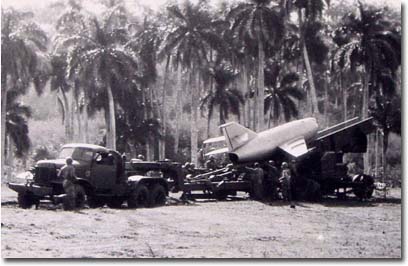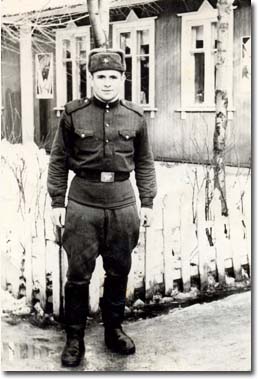MORE POSTINGS
WEEK 2: MISSING OVER THE SOVIET UNION (Posted June 11, 2008)
WEEK 3: TRACING THE NUCLEAR WARHEADS (Posted June 18, 2008)
WEEK 4: THE SHOOTDOWN OF MAJOR ANDERSON (Posted June 25, 2008)
WEEK 5: THE "EYEBALL TO EYEBALL" MYTH (Posted July 2, 2008)
ABOUT THIS SERIES
When Washington Post reporter Michael Dobbs first decided to write a book about the Cuban missile crisis, the question he was most frequently asked was, “What is there new to say about a subject that has been so exhaustively studied?” The answer, it turned out, was “a great deal.” Two years of research in half a dozen countries, including the United States, Russia, and Cuba, turned up a surprising amount of new information about the thirteen days in October 1962 when the world had its closest brush with nuclear destruction. His minute-by-minute narrative also explodes some long-accepted myths, repeated for decades by missile crisis scholars.
Over the next five weeks, the National Security Archive will publish some of the key primary sources behind One Minute to Midnight: Kennedy, Khrushchev and Castro on the Brink of Nuclear War. The new information includes such episodes as a startling Soviet plan to destroy the Guantanamo naval base, the storage and handling of Soviet nuclear weapons on Cuba, and the “Eyeball to Eyeball” confrontation between U.S. and Soviet ships that never happened.
The revelations in One Minute to Midnight shed new light on presidential decision-making at moments of supreme tension. Some of the information that flowed into the Oval Office during the crisis was erroneous. U.S. intelligence analysts seriously under-estimated the number of Soviet military personnel in Cuba and failed to identify the bunkers for Soviet nuclear warheads, despite possessing photographic evidence that is being published for the first time in One Minute to Midnight. Soviet and U.S. leaders consistently misinterpreted each other’s signals.
American scholars have traditionally treated the Cuban missile crisis as a case study in the art of crisis management. The historian Arthur Schlesinger, Jr. praised Kennedy’s “brilliantly controlled…matchlessly calibrated” handling of the Soviets. The new revelations suggest that the crisis is better understood as an example of the limits of crisis management and presidential power. As told by Dobbs, the missile crisis is a case study of “government by exhaustion” in which frazzled policy-makers struggle to master the chaotic forces of history that they themselves helped to unleash. |

The Cuban Missile Crisis, 1962
The 40th Anniversary
Docments, photos, audio clips and more from the historic 40th anniversary conference in Havana
|
THIS WEEK: THE SOVIET PLAN TO DESTROY GUANTANAMO NAVAL BASE
Washington, DC, June 4, 2008 - Soviet nuclear-tipped cruise missiles were ready to destroy the U.S. naval base at Guantanamo had the U.S. military persuaded President Kennedy to invade Cuba during the missile crisis in 1962, according to a new book by Washington Post reporter Michael Dobbs (citing documents and interviews posted here today by the National Security Archive).
The documents show that U.S. intelligence listed the Soviet weapons as "unidentified artillery" pieces, when they were actually cruise missiles armed with Hiroshima-sized nuclear devices. They were deployed to within 15 miles of the Guantanamo base on the same day -- October 27, 1962 -- that the Joint Chiefs of Staff recommended an all-out U.S. invasion of Cuba to destroy the Soviet missile bases. President Kennedy rejected the advice of his military advisers in favor of a diplomatic solution to the crisis that included a secret understanding between his brother and the Soviet ambassador.
The new book, One Minute to Midnight, draws on the National Security Archive's long-standing documentary work on the Cuban Missile Crisis. Dobbs conducted extensive interviews with Soviet combat veterans and discovered previously undisclosed U.S. intelligence documents that explode the myth of successful crisis management and offer new insights into how a U.S. president makes decisions at a time of grave international crisis.
 |
Soviet FKR cruise missile deployed in Cuba. |
Nikita Khrushchev alluded to the nuclear threat hanging over the U.S. Naval base at Guantanamo during a meeting in the Kremlin on October 24, 1962, with the president of Westinghouse, William Knox. According to Knox’s notes on the meeting, Khrushchev said he was not interested in the “destruction of the world” but it was up to the Americans “if you want us to all meet in hell.” He told Knox that the Guantanamo naval base would “disappear the first day” after a U.S. invasion of Cuba. (SOURCE: John F. Kennedy Library)
At the time, Khrushchev’s threat seemed like empty bluster. What Kennedy did not know was that the Soviets had deployed nuclear cruise missiles to Cuba, armed with 14-kiloton warheads, roughly the power of the bomb that destroyed Hiroshima. FKR cruise missile regiments were stationed near the port of Mariel in western Cuba and at Mayari Arriba in eastern Cuba.
At about the time that Khrushchev was speaking with Knox, a convoy of FKR cruise missiles was moving from Mayari Arriba to a pre-launch position at the village of Vilorio. (See map below.) On the night of October 26-27, at the height of the missile crisis, the convoy was ordered to the launch position the village of Filipinas, 15 miles from Guantanamo naval base. Two Soviet soldiers were killed during this deployment when their truck fell down a ravine.
Click on the icons for further details on the FKR deployments (View Larger Map)
 |
Soviet soldier Viktor Mikheev was killed when his truck fell down a ravine near Guantanamo naval base. |
The Marines defending Guantanamo followed the movement of a convoy of several thousand “RUSS/SINO/CUBAN TRPS” transporting “unidentified artillery equipment” from Vilorio to Filipinas. A Navy intelligence message on October 28 gave the precise coordinates for the deployment, but did not identify the FKR cruise missiles. The missiles have remained unidentified until now. (SOURCE: US Navy Historical Center)
The FKR missiles were still in position in Filipinas on November 12, long after the Soviets had begun to dismantle the strategic missile sites. A Navy intelligence document dated November 12 describes the rocket launchers as “probably track vehicle mounted”, escorted by “1000 plus troops.” It added: “This complex is mobile and requires constant surveillance.” (See page 3.) Both the Filipinas and Vilorio sites were targeted for air strikes by A4D Skyhawks, operating out of Roosevelt Roads Air Naval Station in Puerto Rico. (See page 4.) (SOURCE: US Navy Historical Center)
A GITMO Naval intelligence summary dated November 14 reported that ‘missile launching platforms” had still not been dismantled at the pre-launch site at Vilorio. “Reportedly reinforcements have arrived in this area and the perimeter is reportedly guarded by Russian and Chinese troops.” (Note: There were, of course, no “Chinese troops” in Cuba in October 1962. U.S. intelligence was still unconvinced of the Sino-Soviet split and routinely referred to Soviet troops as “Russ/Sino troops.”) The same intelligence summary (page 2) reported the arrival of “three artillery pieces) of unknown type in Filipinas from Santiago de Cuba. (SOURCE: US Navy Historical Center)
The U.S. evacuated 2,810 women and children from the Guantanamo naval base on October 22, shortly before JFK addressed the nation about the presence of Soviet missiles on Cuba. Five thousand U.S. Marines were sent to Guantanamo to reinforce the base, which could have been wiped out by the Soviets in a matter of minutes.
|
US military forces on patrol at Guantanamo naval base. |
If you have Google Earth installed on your computer, you can download the precise coordinates of the Soviet deployment of FKR cruise missiles around Guantanamo by downloading this Google Earth layer and opening it in the free Google Earth application.
 Open 'Targeting Guantanamo' layer in Google Earth Open 'Targeting Guantanamo' layer in Google Earth
If you do not currently have Google Earth installed on your computer, you can access this information by taking the following steps:
1. Download and install the free Google Earth application.
2. Download the Google Earth layer on the Soviet deployment of FKR cruise missles around Guantanamo and open the file using the Google Earth application.
More information on the targeting of the Guantanamo naval base, including the role played by Raul Castro and a shootout between Cuban and Soviet troops, is available in One Minute to Midnight, available through Amazon.com.
MORE POSTINGS
WEEK 2: MISSING OVER THE SOVIET UNION (Posted June 11, 2008)
WEEK 3: TRACING THE NUCLEAR WARHEADS (Posted June 18, 2008)
WEEK 4: THE SHOOTDOWN OF MAJOR ANDERSON (Posted June 25, 2008)
WEEK 5: THE "EYEBALL TO EYEBALL" MYTH (Posted July 2, 2008)
|

